Island in Flames by Miki Bratanic: On This Day in 1943 in Vrbanj on Hvar
January 3, 2021 marks the 78th anniversary of a devastating day for two villages on the island of Hvar, the subject of Miki Bratanic's latest book - Island in Flames.
When I first visited the village of Vrbanj on Hvar back in 2003, I was struck by how many ruins there were in such a living village. Indeed, as I learned, Vrbanj is the biggest village on the island, with over 400 inhabitants. It was only years later that I learned the reason why. For back in 1943, on this very day, the occupying Italian forces burned most of the houses in Vrbanj. Many lay ruined for decades until at least some were renovated after the property boom of 2003-5, as foreigner buyers snapped up enchanting stone ruins on an idyllic Adriatic island. Almost all of them without knowing the reason their new purchases were in such a state of disrepair.
Dalmatian historian and Vrbanj patriot has recorded this troubled period in the island's history with his latest book, An Island in Flames, which is due out shortly.
On this day 3.1.1943. Italian fascists set fire to the villages of Dol and Vrbanj on the island of Hvar. Most of the houses were completely destroyed, and in the middle of winter people were left not only without a roof over their heads, but also without wine and olive oil, the basic source of income from which they lived, which was either spilled or taken away. After that event, a large humanitarian action was launched in Zagreb to collect aid for the victims on the island of Hvar. And many people helped, from ordinary small people, companies, institutions, and municipalities, cities and counties. The rich documentation of the "Committee for Aid to the Victims of the Island of Hvar" from Zagreb, founded by people from the island, preserves, among other things, the payment slip for donations from the city of Vukovar, as well as an interesting list of a ten-member exiled family from Sucuraj.
The Ministry of the Interior and the Ministry of Finance collected aid, both financial and various material forms of footwear, clothing, construction materials, agricultural tools and various other necessities, mostly food, intended for the victims on the island of Hvar.
The board was initially set up to collect so-called aid "Burners" from Vrbanj and Dol victims of the Italian-Fascist arson in 1943, but was of great importance later to the exiles as well from all over the island deported by the German Nazis in 1944.
Among the many requests for help from 1944 there is a list of 25 people from Sucuraj on the island of Hvar who stayed in Šljivoševci, a village in Baranja that belongs to Donji Miholjac, then 53 people in Tiborjevci, then 40 people from various places the island of Hvar who stayed in Šid, 30 people in Brod, and many more them in various other places, mostly in Slavonia.
So this is one big tragic island story, that's why I called it An island on fire, because indeed that flame of war engulfed the whole island.
Thanks to good people, the complete documentation has been preserved on the work of the Committee, so today we can know what the amounts of goods collected and people involved. We also know how they addressed the Committee people from the island of Hvar who were expelled from the island in 1944 and to whom
help was needed, and how their names were preserved in lists and petitions, so this will certainly be a material of interest to many to their descendants or acquaintances.
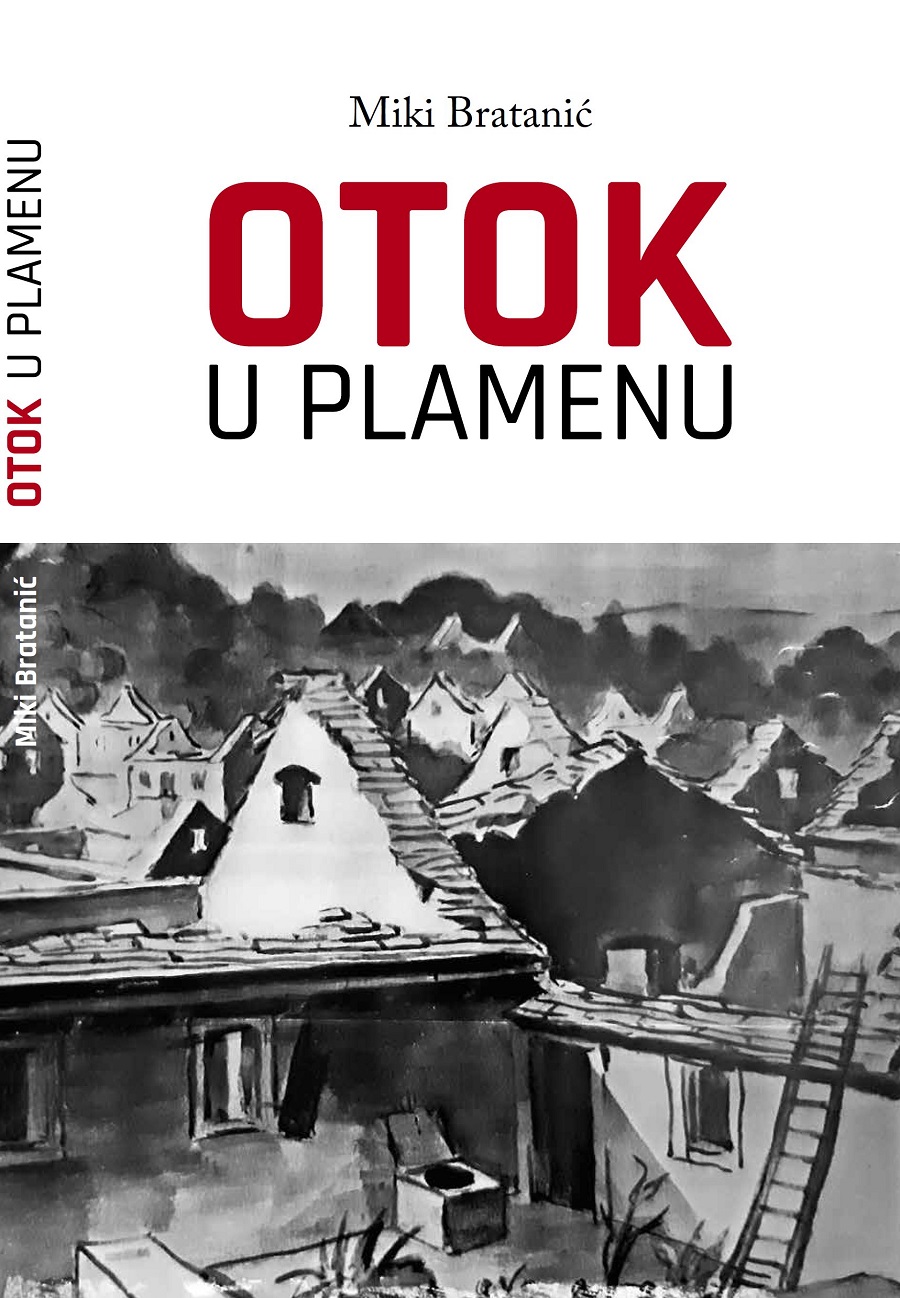
(An Island in Flames, by Miki Bratanic - the painting is by academic painter Bartul Petric, who visited Vrbanj just a few days after this happened).
The first written report on the tragedy of Vrbanj can be found in the telegram the very next day, January 4, 1943, addressed to Bishop Miho of Hvar by the parish priest of Vrbanja, Don Ivo Šeperica:
Yesterday the Italian authorities set fire to the village of Vrbanj, and about 180 houses in ruins, about 60 were rest spared, but the people were left without housing, without food, without suits, without beds and blankets and no money people in a desperate state of food. Send everything to Vrbanj so that the people do not suffer report the matter to the county authority let them stand up for the people regarding food. Also, you should know there are two victims so far.
The initiation of assistance at the highest state level was encouraged by the bishop Hvar's Miho Pušić in a letter sent on January 7, 1943 to the Ministry of the Interior, in which he reports on the difficult situation on the island of Hvar and begs for help. On the same day, Bishop Pušić sent a telegram to the then Archbishop of Zagreb Alojzije Stepinac, asking him for personal engagement and warning in a special way how the Italian military authorities threatened to destroy the entire island if any of their soldiers are killed.
The rest is history, recorded in a hundred documents that are here find to witness one great tragedy, but also one great one humanitarian action that our island of Hvar may never have in history did not experience. Many will be able to find their family in them a story, or an example of what kind of people we have to be in difficult times.
An Island in Flames will soon be available. For the latest news on how to get it, as well as more from the fabulous Miki Bratanic, check out his official website.
Za Križen 2020 kako ga je vidio križonoša iz Vrbnja Matteo Bratanić
22. travanj, 2020 - 500 godina stara procesija Za Križen na Hvaru, koju je zaštitio i UNESCO, jedan je od rijetkih događaja koji su se ovoga mjeseca održali u Hrvatskoj. Pročitajte intervju s križonošom iz Vrbnja, Matteom Bratanićem i zavirite iza kulisa ovog događaja.
1943. godine talijanski fašisti ograničili su procesiju na samo 12 osoba po mjestu, a 1944. ona je održana u izbjegličkom kampu u pustinji Sinai u Egiptu. Procesija Za Križen koja se održava na Hvaru od 1510. godine 2009. je godine uvrštena na popis nematerijalne baštine UNESCO-a sastoji se od šest istovremenih procesija iz Jelse, Pitvi, Vrisnika, Vrbnika, Svirča, Vrbnja i Vrboske koje prate bosonogog križonošu dok kroz noć hoda preko 25 kilometara na hodošašću u molitvi. I dok je većina drugih događanja u Hrvatskoj ovoga mjeseca otkazana, Za Križen je kontroverznom odlukom dopušteno da se održi, iako u ograničenim okolnostima. Dok svake godine stotine ili čak tisuće ljudi sudjeluju u procesijama, Za Križen 2020 je bila ograničena na samo 15 osoba po procesiji.
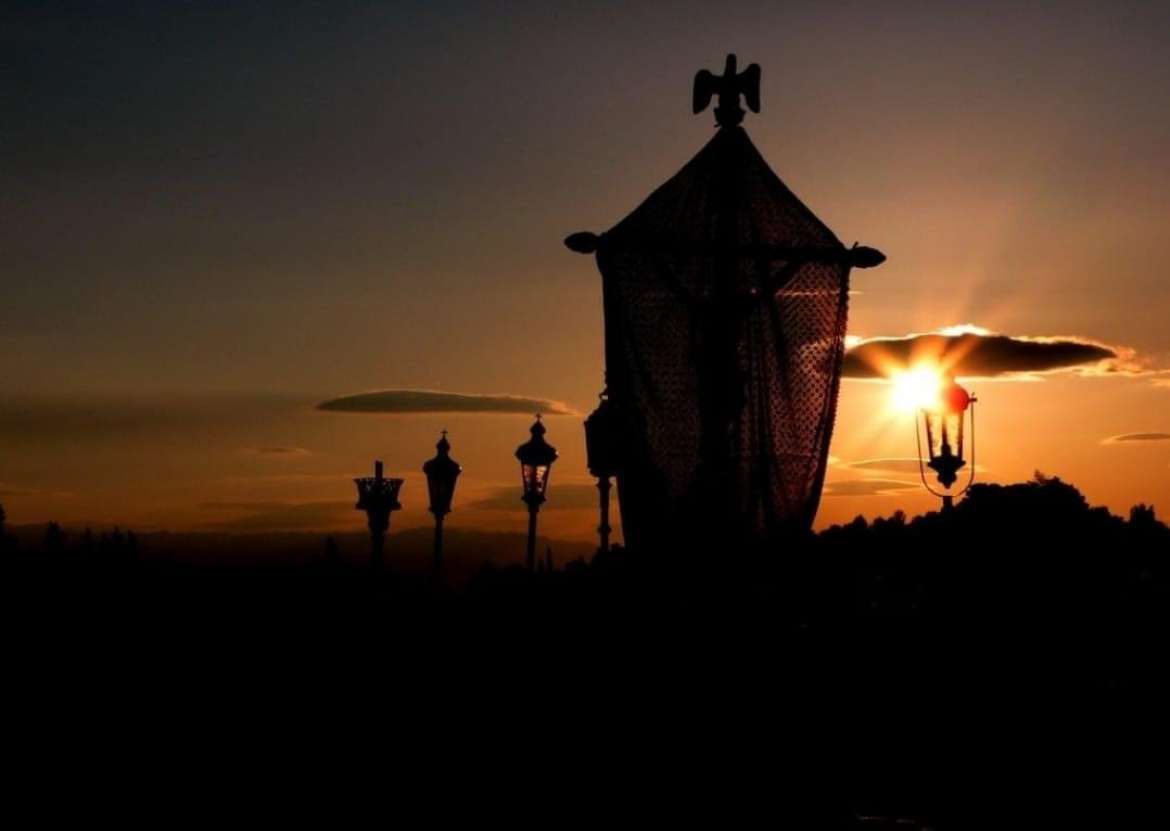
TCN je bio jedan od rijetkih svjedoka procesije Za Križen 2020. Detaljan opis događanja možete pročitati u našem članku an see our detailed account in Jelsa Za Križen, Hrvatska nije Wuhan, i osjećaj kabinske groznice.
Pa, kako je bilo nositi križ tijekom najčudnije godine procesije Za Križen, i kako je to sve izgledalo iza kulisa? Zahvalan sam križonoši iz Vrbnja Matteu Brataniću na ovom fascinantnom i detaljnom izvještaju o procesiji, pripremama za nju i onome što je nakon nje slijedilo, iz perspektive jednoga od šest muškaraca koji su nosili križ.
Za početak nam recite, kada ste se prijavili da budete križonoša za Vrbanj? Prije koliko vremena?
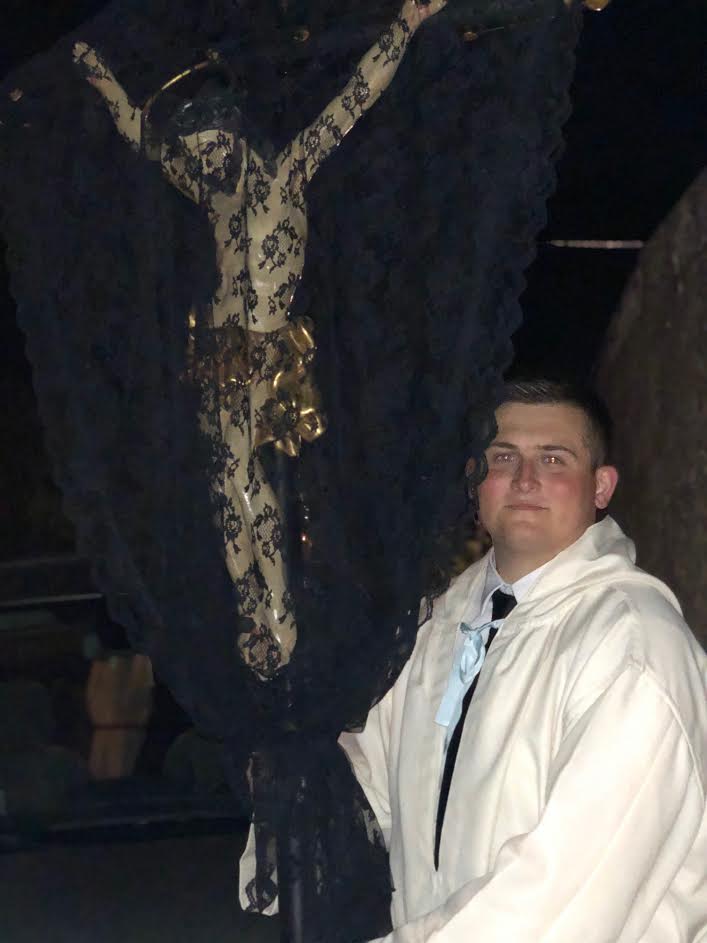
Zapravo, nisam se sam prijavio da budem križonoša. To je učinio moj pokojni djed 2000. godine, kada je moj stric, dr. Andre Bratanić nosio križ. Tada sam imao 14 mjeseci. Nažalost, moj djed koji me prijavio preminuo je u rujnu prošle godine, tako da nije dobio prigodu vidjeti kako sam mu ispunio želju.
Kako bi pripreme za procesiju izgledale normalne godine?
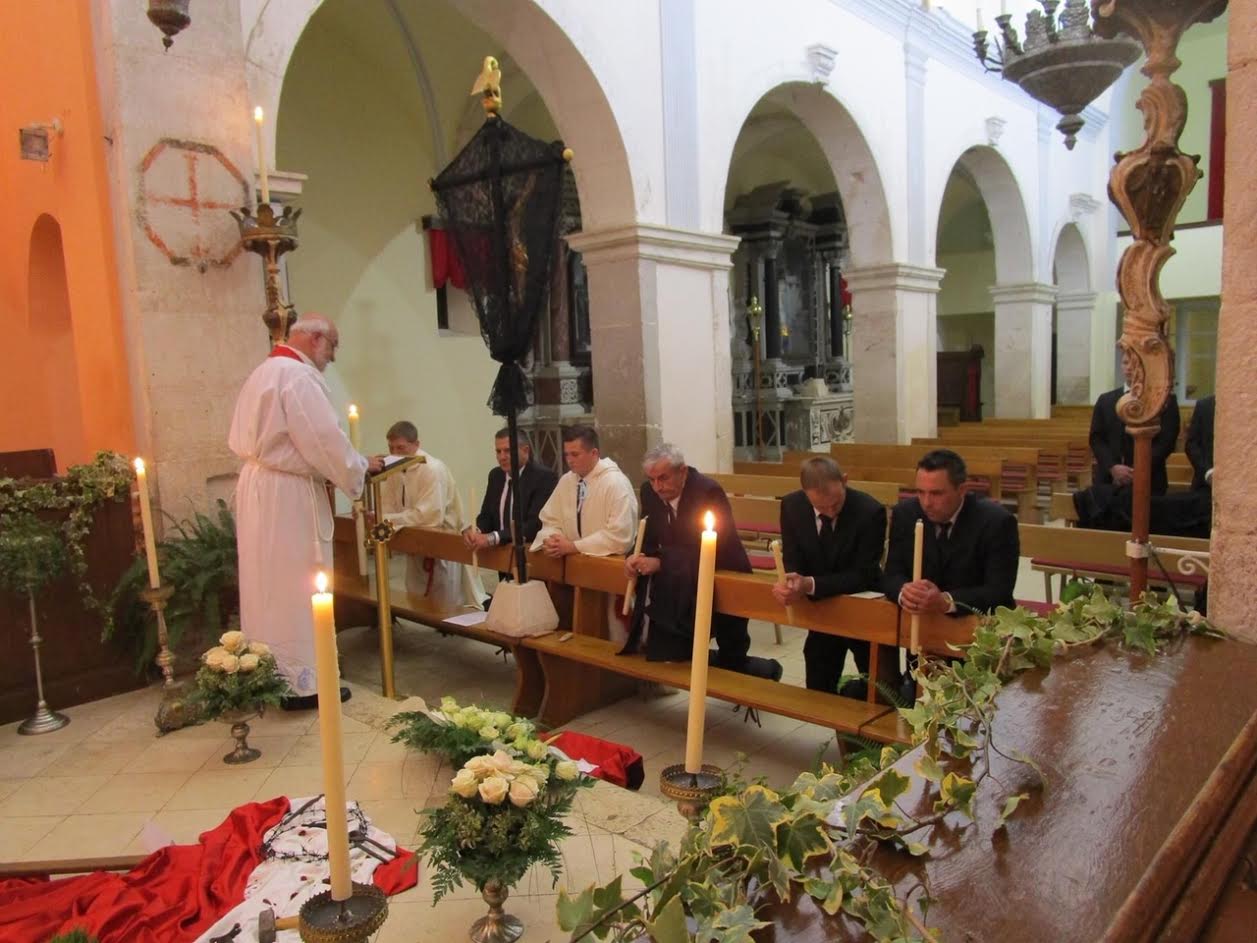
Čak su i ove godine pripreme normalno počele. Ljudi koji su bili uključeni u organizaciju procesije dolazili su u našu kuću na večere, „Kantaduri“ su uvježbavali pjesmu „Gospin Plac“ i zajedno smo vježbali pjesme koje se pjevaju kad se stiže u različita mjesta. Naravno, potrebno je pripremiti se i kroz crkvu, odlaskom na misu svake nedjelje, kroz ispovijed na početku Korizme i pomalo se duhovno pripremati za ono što dolazi.
Kako se mentalno i fizički pripremiti za takvo nešto?

Mentalno, morate si utuviti u glavu da to nije nešto nemoguće. Mnogi su prehodali 25 km noseći križ težak 8 kg i ti ćeš biti jedan od njih. Nema potrebe za panikom. Da budem iskren, kad smo iz Vrbnja krenuli na procesiju, sve o čemu sam mogao misliti bilo je "O Bože, u što sam se uvalio, kako ću ovo izdržati“ itd. Ali svećenik koji je donedavno bio u Vrbnju, don Branimir, rekao je vrlo istinitu stvar s kojom se u potpunosti slažem: „Od Vrbnja do Vrboske: ti nosiš križ. Od Vrboske nadalje križ nosi tebe“. Kad uspijete pronaći ugodan položaj za nošenje, postane stvarno lako. Fizički, moraš biti pripremljen nositi križ težak 8 kg, pa je bitno imati snage u gornjem dijelu tijela. Zbog pandemije nije bilo mnogo toga za raditi, pa bih se zaključao u svoju sobu i radio sklekove i trbušnjake, a uz to sam pomagao ocu na polju, u što je uključeno mnogo dizanja teških predmeta. Uz to sam zaista aktivan. U Kanadi igram nogomet i redovito idem u teretanu, pa nisam bio zabrinut. Izdržljivost je ključ da biste mogli izdržati svih 25 kilometara. Svi znamo da nije cijeli put po ravnome – dio prema Pitvama je najteži jer je uzbrdo cijelim putem. Zahvaljujući igranju nogometa i čestim odlascima na planinarenje i hodanje, bio sam spreman i zaista sam se dobro osjećao. Kada smo se ujutro vratili u Vrbanj, bio sam spreman za odraditi još 25 kilometara.
Ovo nije bila normalna godina. Kada ste shvatili da Za Križen 2020 neće biti kao prethodnih godina, ako se uopće bude održala?
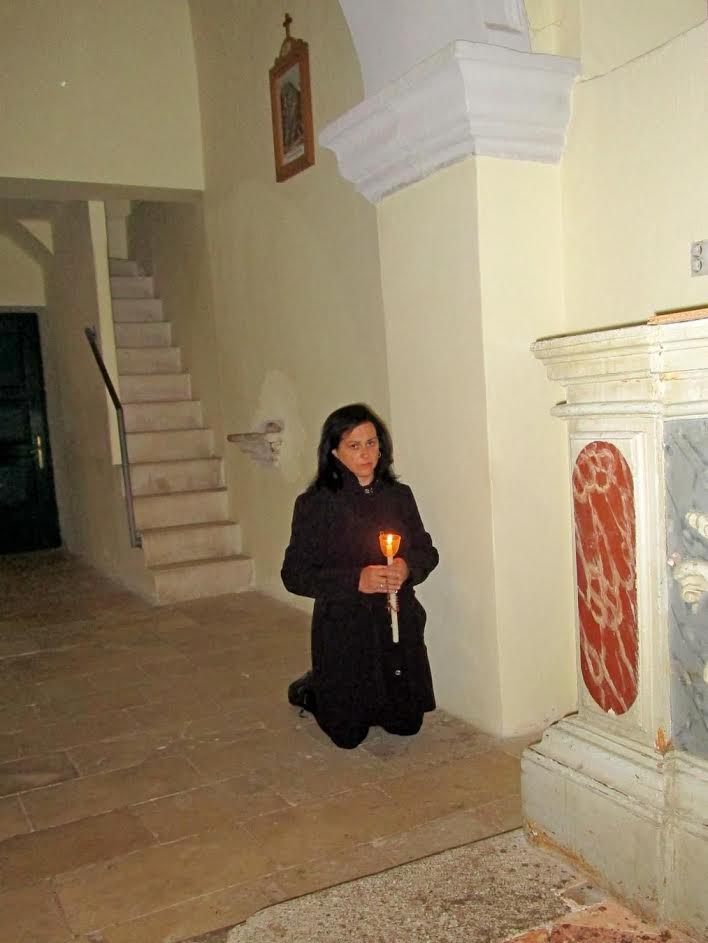
1943., 1944. i 2020. bit će godine kojih će se ljudi ponajviše sjećati. Meni je postalo jasno da će ova godina biti posebna kada je hrvatska Vlada uvela restrikcije (zatvaranje ugostiteljskih objekata, ograničavanje broja kupaca u dućanima, zabrana okupljanja itd.). Otprilike dva tjedna prije procesije dobili smo naredbu od policije da smiju ići samo troje ljudi plus križonoša u procesiji. Tjedan dana nakon toga, broj je povećan na deset ali nakon još nekoliko dana broj je smanjen na pet. Zahvaljujući naporima Antonija Škarpe, gradonačelnika Staroga Grada, Marija Lušića-Bulića, člana crkvenog odbora Vrbnja i Mika Belića Kice, predsjednika crkvenog odbora Jelse, broj je vraćen na deset ljudi. Zahvaljujući naporima glavnog „Stožera“ u Zagrebu, dopušteno nam je da u procesiji bude petnaest ljudi, što je donijelo mnogo olakšanja meni, mojoj obitelji i cijelome Vrbnju.
Ispričajte nam kako ste se osjećali kada je rasprava o ovom pitanju stigla na stol hrvatskog Premijera.
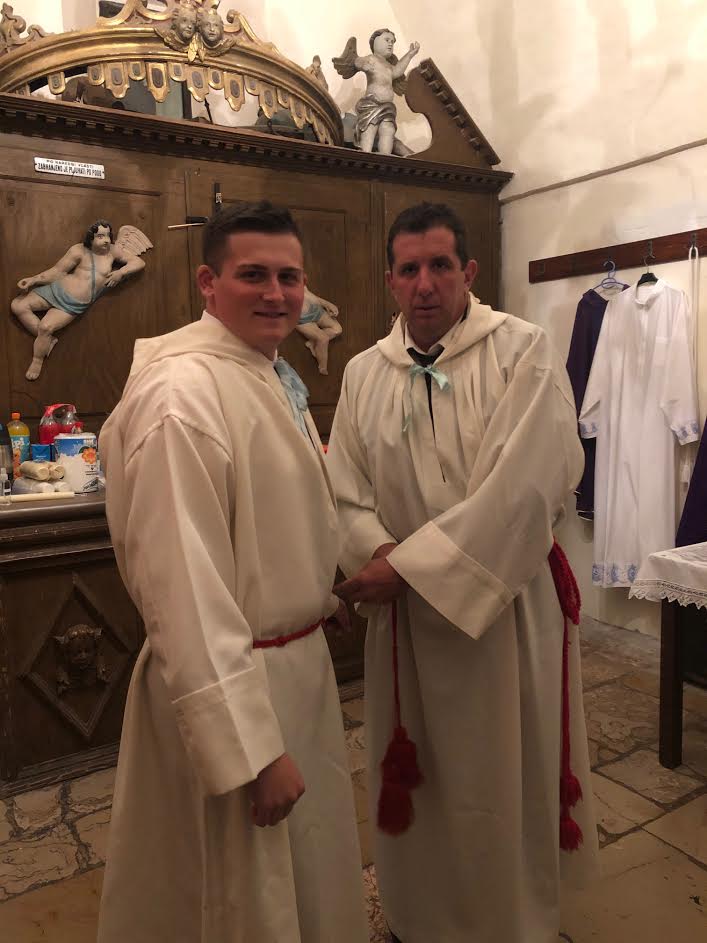
Kako smo znali da je Premijer Plenković s Hvara i da je redoviti posjetitelj ovog događaja, bili smo uvjereni da će se procesija Za Križen održati, ali nam je broj sudionika bio misterija. Bili smo mentalno spremni na originalnih pet članova procesije ali kada je dan prije održavanja stigla vijest da će moći ići petnaest osoba, osjećali smo samo zahvalnost i sreću.
Kako su izgledale rasprave o tome kako nastaviti, koliko je blizu bila odluka da se sve otkaže?
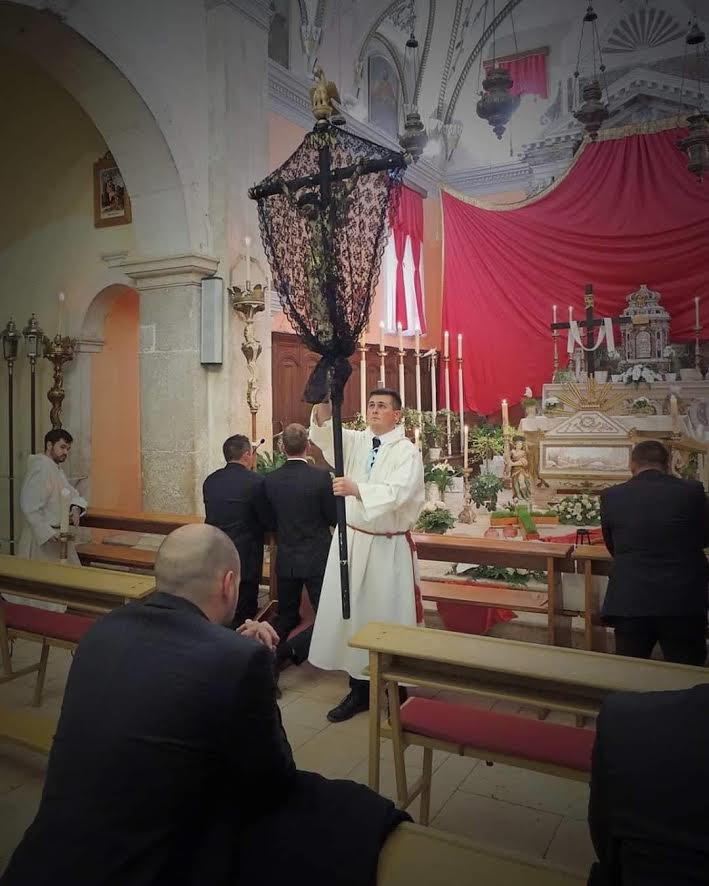
Kao što sam već rekao, bili smo spremni da će se procesija dogoditi uz sudjelovanje po pet osoba. Svima nama glavni fokus je bio da svih šest križeva prođe, tako da se ne prekine petstogodišnja tradicija. Moglo se lako dogoditi da tradicija bude otkazana, ali znam da sam ja osobno bio spreman krenuti sam uz pomoć svog oca, samo da izbjegnemo otkazivanje tradicije. Govorkalo se da bi se procesija mogla odgoditi na rujan, ali nitko na otoku nije bio sklon tome rješenju jer to jednostavno ne bi bilo isto. Slavimo Kristovu smrt i uskrsnuće u ovo doba godine s razlogom… Procesija ne bi imala nikakvog smisla kada bi se održavala u bilo koje drugo doba godine.
Drugdje u Hrvatskoj bilo je mnogo ljutnje što je dozvoljeno da se održi procesija Za Križen. Što kažete na to?
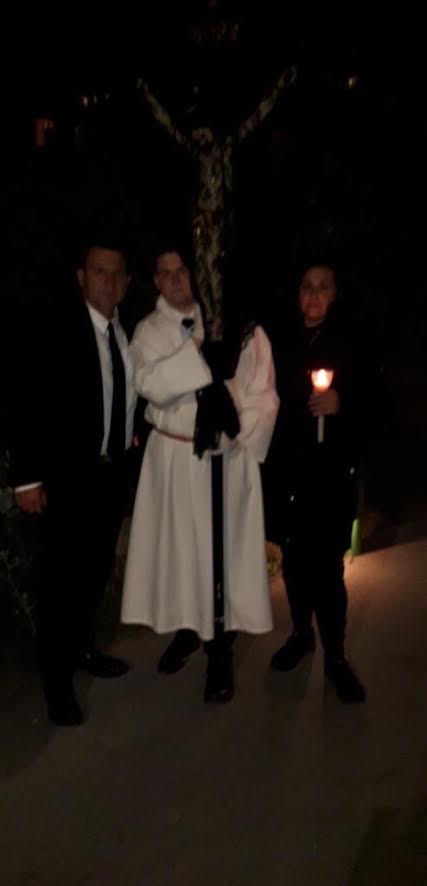
Uz Hrvatsku i cijeli svijet usred ove pandemije, razumijem zašto su ljudi koji ne žive na Hvaru bili uzrujani. Stanovnici Hvara izolirani su 365 dana u godini i ovo je među rijetkim događajima kojima se stvarno vesele svake godine. Uz pažljivu pripremu procesije od strane „Stožera“ i policiju kao i sudionike koji poštuju sva pravila i odredbe koje su im dane. Prije procesije na Hvaru nisu zabilježeni slučajevi infekcije, tako da nije bilo posebne opasnosti. Srećom, nakon procesije možemo potvrditi da na Hvaru još uvijek nema slučajeva zaraze virusom, stoga velika zahvala svima koji su sudjelovali u procesiji na tome što su slijedili pravila!
Ljudi izvan Hvara ne dijele našu strast i osjećaje prema tradiciji staroj 500 godina, koje osjećaju stanovnici otoka. Posve razumijemo zabrinutost i prigovore koje smo čuli i mnogi od njih su bili u redu, ali postoje neke granice i linije koje se ne bi trebalo proći. Kada su ljudi počeli pokazivati manjak poštovanja prema crkvi, procesiji i na kraju prema samome Bogu, posebno kada ne razumiju koliko ova procesija znači stanovnicima Hvara, to je „prelaženje granice“. Mi koji imamo snažne pozitivne osjećaje prema crkvi, procesiji i Bogu bili smo iznervirani i osjećali smo manjak poštovanja zbog nepotrebnih komentara koji su išli protiv naših vjerovanja. Meni se čini da bi se tu trebalo primijeniti nešto što smo naučili u osnovnoj školi: „ako nemaš nešto pametno ili lijepo za reći, onda radije šuti.“
Kako je izgledala procesija kada je konačno krenula?
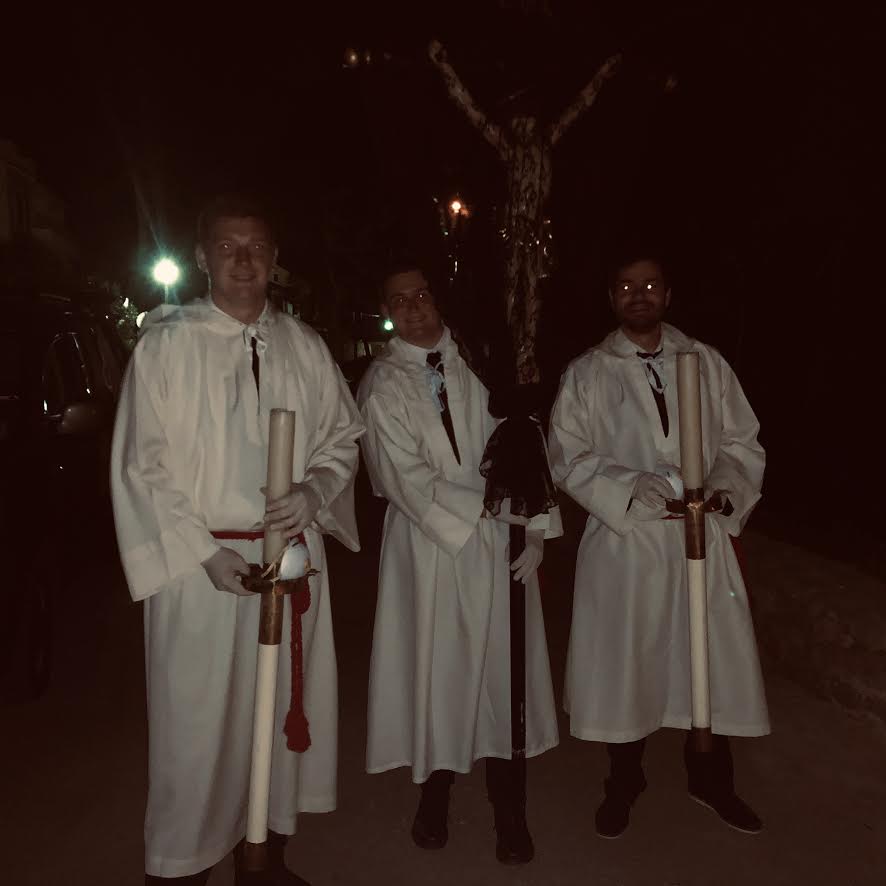
Cijeli Hvar bio je uzbuđen i osjećao je zahvalnost. Ja sam bio posebno sretan jer sam na tu prigodu čekao dvadeset godina i konačno sam mogao slijediti stope svoga oca, djeda, strica i pradjeda u nošenju križa, ali sam bio još sretniji jer sam bio jedan od križonoša ove godine, koji su dobili priliku nastaviti ovu svetu tradiciju umjesto da ona bude prekinuta. Nitko nije očekivao da će ova godina biti „posebna“, ali ni ja ni moja obitelj ne možemo biti sretniji kako je na kraju sve ispalo. Cijela ovogodišnja Korizma bila je ispunjena molitvom kroz mise prenošene na televiziji koje su doprinosile duhovnoj pripremi. Sama procesija bila je malena, ali prekrasna i prepuna molitve. U procesiji smo imali dvojicu koji su predvodili molitvu cijelu noć. Uspjeli smo uključiti i dvojicu vrlo talentiranih pjevača iz Vrbnja koji su pomogli da naša pjesma kroz noć zvuči predivno. U Pitvama smo čuli komentar kako su impresionirani našim pjevanjem, jer je u crkvi bilo samo 10 ljudi koji su pjevali, a zvučalo je kao da ih je stotinu.
Vaša obitelj i stanovnici Vrbnja učinili su krasnu gestu za žrtve potresa u Zagrebu. Ispričajte nam više o akciji 'Varbonj za Zagreb'.
Usred priprema za procesiju Za Križen, prije otprilike mjesec dana, Zagreb je pogodio potres koji je oštetio mnoge domove i crkve. Istovremeno, nas su udarali neugodni komentari ljudi koji su bili protiv održavanja procesije. Moj otac i ja odlučili smo da ćemo pokloniti sva novčana sredstva koja smo primili kao poklon, u korist večere na Veliki Četvrtak i ručak (Obid od Križa) na Uskršnji ponedjeljak. Ako bi nas netko darivao poklonom koji nije novčani, izračunali bismo njegovu vrijednost i donirali bismo taj iznos iz našeg džepa za Zagreb.
Predložili smo ovu ideju don Mili Plenkoviću, svećeniku iz Vrbnja i crkvenom odboru, koji su to rado prihvatili i kampanju nazvali "Varbonj za Zagreb - Za Križen 2020". Također su odlučili da će i sav novac prikupljen tijekom Svetog Tjedna u crkvi, takozvanu „lemozinu“, također darovati u taj fond. Kada je sve završeno, tjedan dana nakon Uskrsa, s ponosom možemo reći da smo prikupili 100.000 kuna. 50.000 kuna bit će uplaćeno u fond koji je Vlada Republike Hrvatske otvorila za pomoć Zagrebu. Preostalih 50.000 uplatit ćemo na račun "Kuće sv. Terezije od Malog Isusa za nezbrinutu djecu" u Zagrebu. Radi se o instituciji koju vode Karmelićanke presvetog srca Isusova. Brinu se za djecu bez prikladne roditeljske skrbi. Potres je znatno oštetio njihovu zgradu u centru Zagreba, pa su je morali napustiti dok se ne obnovi.
I kako se sad osjećate, kada je proteklo dva tjedna od procesije? Sigurno je to za vas bilo posebno emocionalno vrijeme.
(Fascinantan prilog Hvar TV-a s križonošom iz Pitvi 2012)
Za Krizen 2020 Through the Eyes of Vrbanj Cross-Bearer Matteo Bratanic (Interview)
April 22, 2020 - The 500-year-old UNESCO Za Krizen procession on Hvar was one of the only events to take place in Croatia this month. An in-depth interview behind the scenes with Vrbanj cross-bearer, Matteo Bratanic.
In 1943, the Italian fascists limited it to just 12 people per procession, and in 1944, it took place in a refugee camp in the Sinai desert in Egypt. For more than 500 years, the Za Krizen procession on Hvar, which became inscribed as UNESCO intangible heritage in 2009, has taken place each year since 1510, with six simultaneous processions from Jelsa, Pitve, Vrisnik, Svirce, Vrbanj and Vrboska following a shoeless cross-bearer on an overnight, 25-kilometre pilgrimage of reflection and prayer. And while almost all events in Croatia have been cancelled this month, Za Krizen was controversially given permission to go ahead, albeit in much-reduced circumstances. Whereas hundreds or even thousands take part each year, Za Krizen 2020 was limited to just 15 people per procession.

TCN was one of the few eye-witnesses of Za Krizen 2020. You an see our detailed account in Jelsa Za Krizen, Croatia Not Wuhan, & Cabin Fever Perspectives.
So what was it like to carry the cross in this most unusual Za Krizen year, and what was the story behind the scenes? I am very grateful to Vrbanj cross-bearer Matteo Bratanic for this fascinating and comprehensive view of this year's procession, preparations and aftermath through the eyes of one of the six men who carried the cross. Matteo Bratanic was the cross-bearer for Vrbanj.
Tell us firstly when you signed up to carry the Vrbanj cross? How long ago?

I wasn't actually the one who signed myself up to carry the Vrbanj cross. It was my late grandfather who did in 2000 when my uncle, Dr. Andre Bratanic carried the cross. I was 14 months old. Unfortunately, my grandfather, who signed me up, passed away in September of last year and didn't get the chance to see me completing his wish.
In a normal year, how would preparations look like?

How do you prepare yourself mentally and physically?

This was not a normal year. When did you realise that Za Krizen 2020 would not be like previous years, if it went ahead at all?

Tell us about your emotions as discussions went to the desk of the Prime Minister.

How were discussions about how to proceed, and how close was it to being cancelled?

There was a lot of anger elsewhere in Croatia that Za Krizen was allowed to proceed. What do you say to that?

How was the procession for you when it finally went ahead?

Your family and the people of Vrbanj did a very nice gesture for the earthquake victims of Zagreb. Tell us about 'Varbonj za Zagreb.'
And how do you feel now, 2 weeks later? It must have been an incredibly emotional time for you.
(Hvar TV with the 2012 Pitve cross-bearer behind the scenes - fascinating report)
Varbonj za Zagreb Earthquake: 100,000 Kuna Za Krizen Proceeds
April 22, 2020 - The final chapter of Za Krizen 2020, as the Varbonj za Zagreb earthquake appeal reaches 100,000 kuna. A message from cross-bearer Matteo Bratanic.
As previously reported on TCN, the UNESCO-listed Za Krizen religious procession on Maundy Thursday was one of the few events to be allowed to take place in this corona era, albeit in strictly controlled circumstances (you can see the detailed TCN eye-witness account of the 9-hour procession).
Matteo Bratanic, the Vrbanj cross-bearer, his family and the people of the village of Vrbanj decided to donate all the proceeds from Za Krizen 2020, including a monetary value on all gifts received, to victims of the devastating earthquakes in Zagreb last month. As I wrote last week, Matteo's father Toni, explained a little more about the Varbonj za Zagreb campaign (Varbonj is a dialect word for Vrbanj), as well as inviting people to contribute until last Sunday.

Varbonj za Zagreb: Za Krizen 2020 Proceeds Donated to Earthquake Victims
April 13, 2020 - After all the media attention about Za Krizen 2020, what a beautiful footnote and gesture - Varbonj za Zagreb.
People often ask me what is my favourite time of year on Hvar, and my answer always surprises them.
Most expect me to talk about the summer, or perhaps the more relaxed shoulder seasons. While these are amazing, if I could only visit my adopted island once a year, it would not be then.
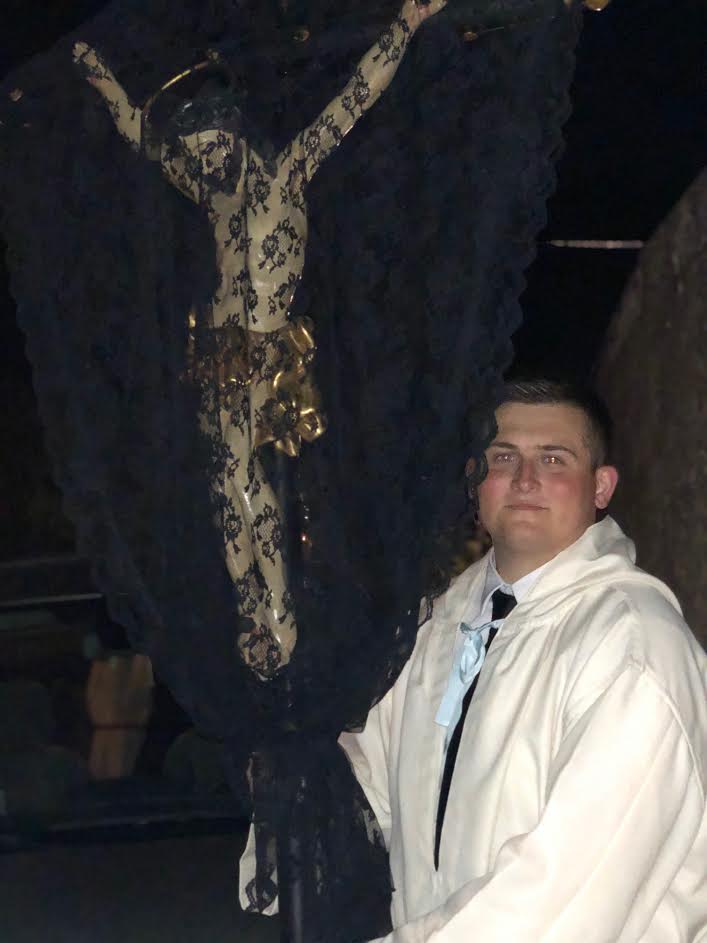
It would be Easter.
There is so much joy and celebration in the air, as the island wakes from its winter slumber, returning islanders home for the long weekend, enjoying family reunions amid this most important of Catholic events.
After days of silence, the sound of the peeling of the Jelsa bells on Easter Sunday morning is one of the most joyous sounds imaginable, as was evidenced by the number of people who liked, shared and tagged others when I posted the video above from our terrace two days ago.
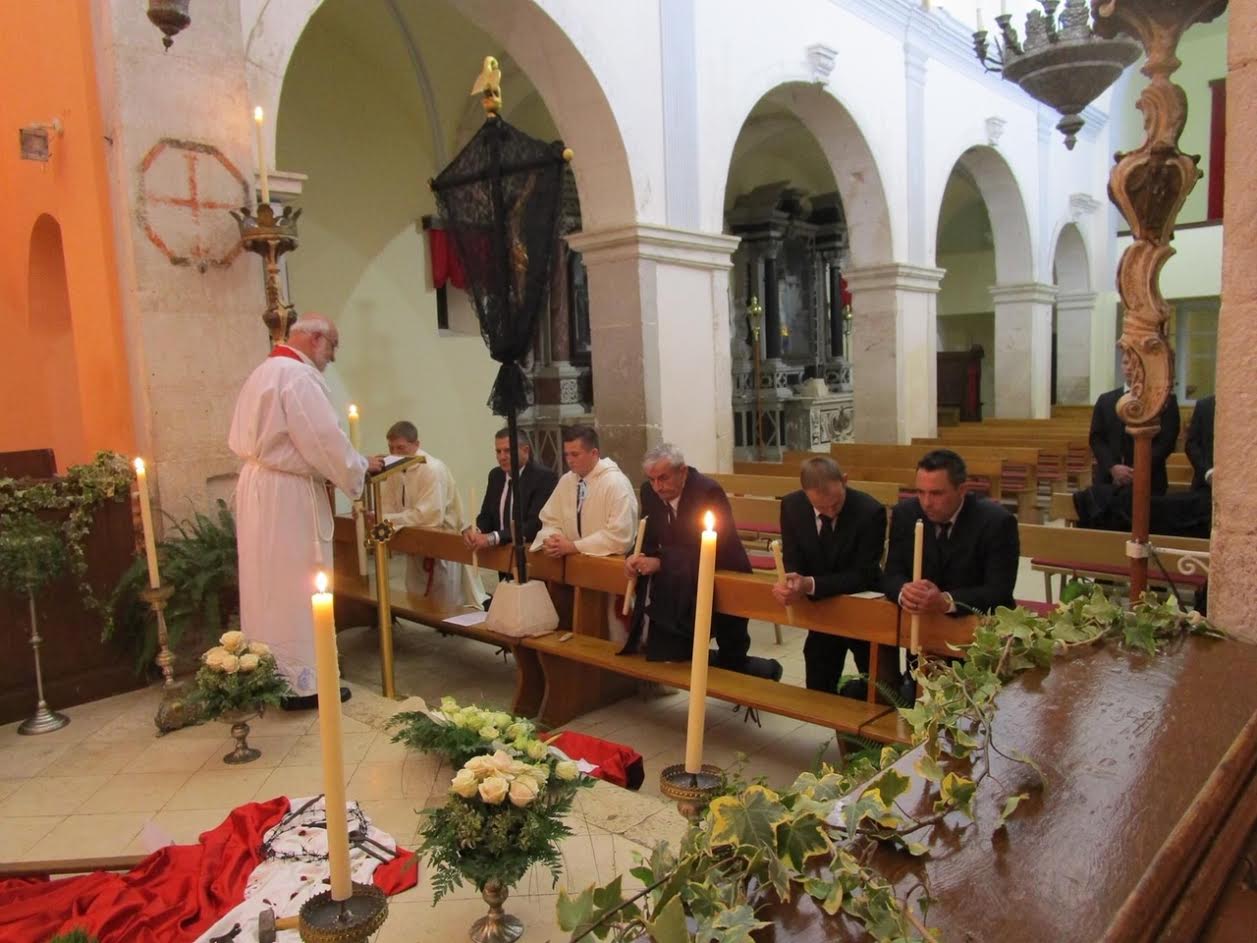
I was very fortunate to be able to attend the entire Za Krizen 2020 in Jelsa, and I managed to capture all six processions. I was also very happy to be able to contribute my eye-witness account of the whole evening, which differed considerably from what was reported second-hand elsewhere. You can read Za Krizen 2020, Croatia Not Wuhan & Cabin Fever Perspectives. (You can also find a Croatian version here)
I had the loveliest phone call of 2020 so far earlier today from Toni Bratanic, the father of this year's cross-bearer from Vrbanj (Varbonj in dialect). He thanked me for the TCN coverage, including the video of Vrbanj entering Jelsa which was edited by my wife Miranda (above).
And then he told me about a little initiative called Varbonj za Zagreb. Rather than me trying to explain it, here is what Toni sent me in an email which followed.
Varbonj za Zagreb – Za Križen 2020
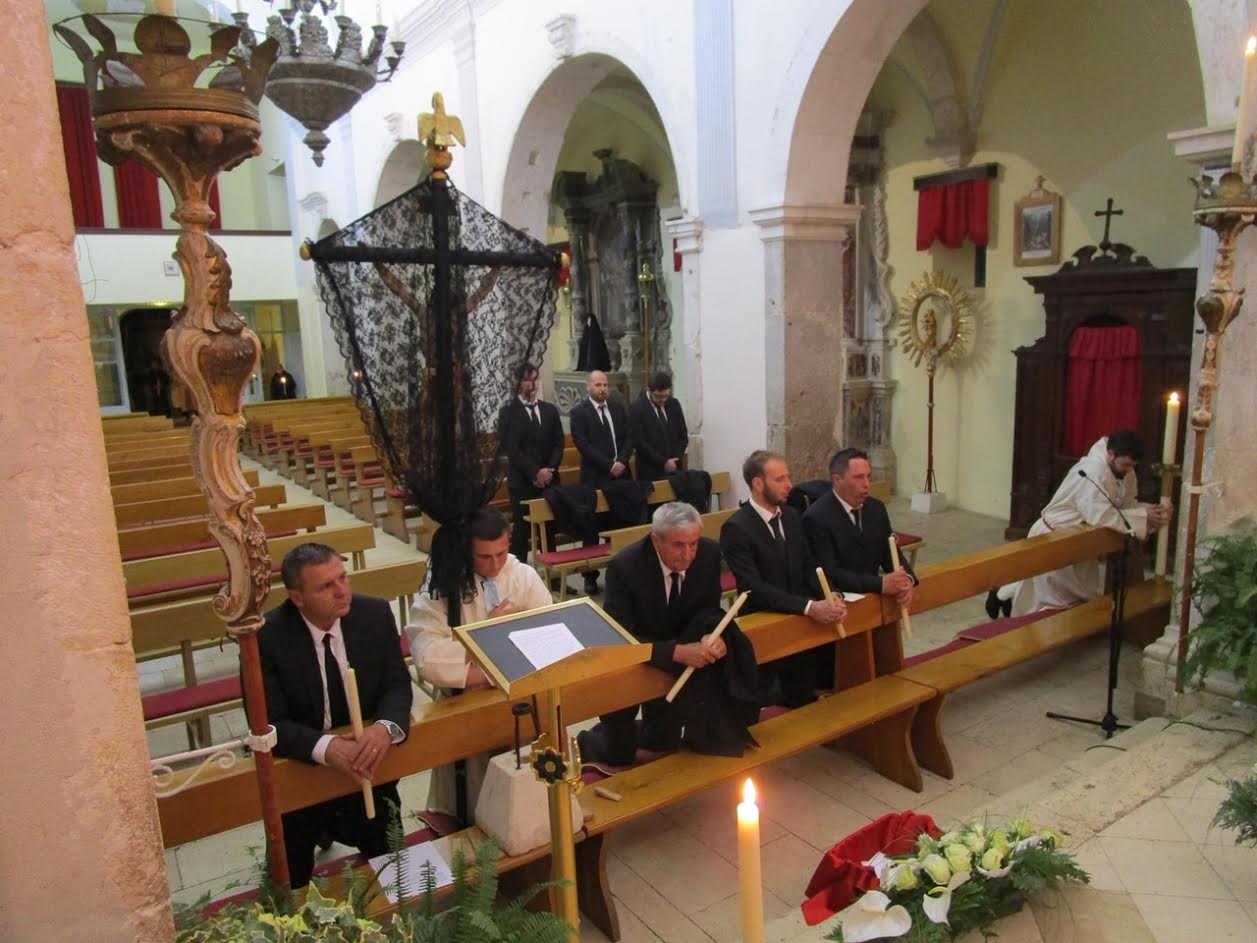
Dear parishioners and all people of goodwill!
On the proposal of the family of Mateo Bratanic, this year’s “Križonoša” and with the support of the parish economic council, we are launching a humanitarian action for Zagreb called “Varbonj za Zagreb – Za Križen 2020” due to the recent earthquakes that occurred there. This benefit, which is very special, has taught us, among other things, about solidarity, in this case towards those who are left without a roof over their heads. And so, a little village by the name Varbonj decided to help the big city of Zagreb. A long-term tradition is that all of those who are in “Čosti” for “Za Križen,” donate physical and/or monetary gifts. Even people who are not in “Čosti” usually take part as well. This year’s Križonoša, Mateo, has decided to give up all gifts in favor of this action and all money planned to spend on lunch and dinner after Easter which is usually held for people who took part in helping in any way during the preparations and actual procession. In addition to gifts given to Mateo, people will be able to give donations to the Varbonj’s priest, don Mili Plenkovic but also directly to the church bank account.

The account number is HR5824070001100623865 and make sure to provide a note “Varbonj za Zagreb” in the description. The parish will also donate “lemozinu,” money collected during Holy Week. We will be collecting donations until next Sunday April 19th, 2020. This is when we will be announcing the total amount that we have collected.
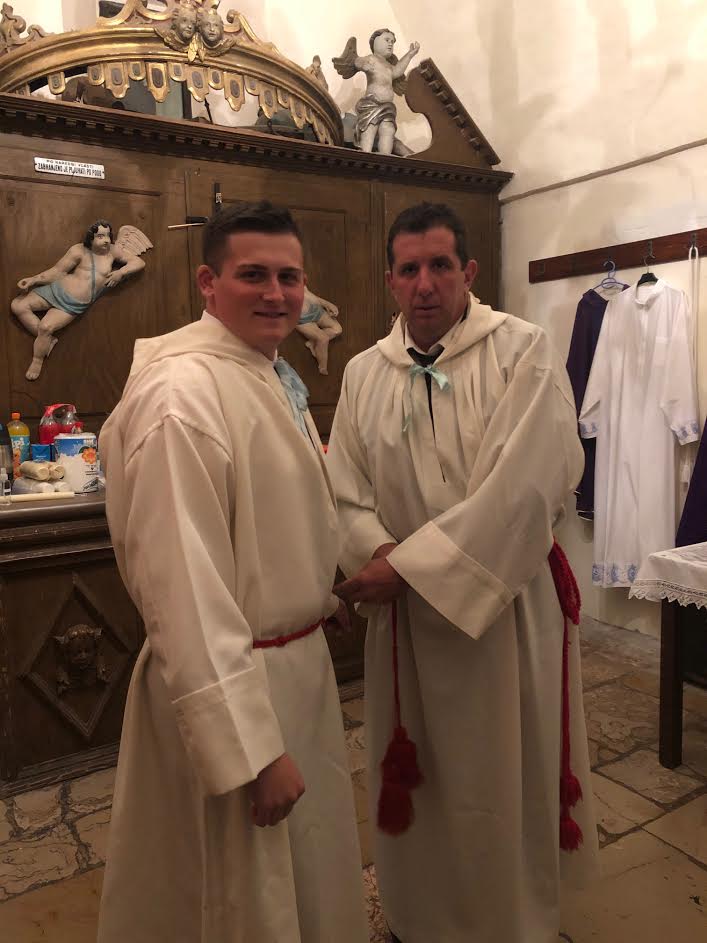
Thank you and God bless!
A nice postscript to a very emotional week here on Hvar. I will write an article about the amount raised after the final amount is known after Sunday.
For more on TCN's coverage of Za Krizen 2020 and previous years, visit the dedicated section.
From Hvar to Napa and Silicon Valleys: Story of the Konoba Told in California
Miki Bratanić, author, poet, and volunteer cultural ambassador, took his story about the humble Dalmatian konoba from the small village of Vrbanj on Hvar, all the way to the Napa and Silicon Valleys of California.


